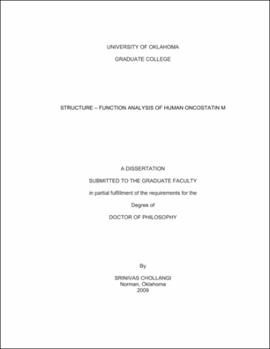| dc.description.abstract | Oncostatin M (OSM) is a pleiotropic cytokine that belongs to the interleukin-6 (IL-6) family of cytokines. These cytokines play crucial role in diverse biological events like inflammation, neuroprotection, hematopoiesis, metabolism and development. For example, when exposed to moderate levels of oxidative stress (i.e. bright cyclic light), IL-6 family cytokines are strongly upregulated in the retina. Using inhibition studies, we show that these upregulated cytokines play an essential role in protecting the neuronal cells from succumbing to subsequent lethal doses of oxidative stress. This wide range of functions elicited by IL-6 family cytokines are mediated by the formation of multimeric receptor complexes, which include a common receptor glycoprotein 130 (gp130). OSM is unique in this family since it can signal via two different receptor complexes i.e. LIFR:gp130 (type I) and OSMR:gp130 (type II). We have identified a unique helical loop on OSM between its B and C helices, which is not found on other IL-6 family cytokines. Based on its size and location, we hypothesized that the BC loop is responsible for OSM's unique ability to bind and activate OSMR. However, our experiments with mutated OSM molecules that have truncated BC loops showed that the BC loop does not play a role in OSM's unique ability to bind OSMR, but instead presents a steric hindrance for OSM's strong interaction with OSMR and LIFR. Kinetic and equilibrium binding analyses using surface plasmon resonance (SPR) and enzyme-linked immunosorbent assay (ELISA) support the evidence for improved binding and stability between mutant OSMs and the receptor complexes. Also, as a consequence of improved binding, these structurally modified OSMs exhibit enhanced ability in suppressing the proliferation of A375 melanoma cells and also protecting the neuronal cells in retina from oxidative stress, demonstrating that improved binding has functional consequences. Finally, we have evaluated the applicability of poly(ethylene glycol) (PEG) based hydrogels for delivering these molecules in a controlled manner. Using in vitro and in vivo studies in mice, we show that PEG hydrogels fabricated with PEG-diacrylate macromers with a molecular weight of 5000 Da can be used to deliver these cytokines in a sustained manner for ~12 days. And, for transscleral transport, a release rate of at least 0.5 ug/day is required for OSM to cross the scleral barriers and reach the retina to induce STAT3 activation. | |
